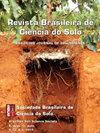Phosphorus lability in a subtropical Acrisol under long-term integrated crop-livestock system: impacts of grazing management and cropping system
IF 2
4区 农林科学
Q3 SOIL SCIENCE
引用次数: 1
Abstract
: Studies on lability of soil phosphorus (P) under integrated crop-livestock systems (ICLS) are still scarce, especially for deep soil layers (more than 0.20 m depth) and different managements in the crop and livestock phase. Distinct management in these phases may lead to a different distribution of soil P pools according to its lability (labile, moderately labile, less labile and residual) and, consequently, the P availability for plant nutrition. This study aimed to determine the soil P pools, by P fractionation and its distribution in lability classes. In a long-term ICLS experiment of grain and sheep production established in 2003, in Southern Brazil, we sampled in 2017 the 0.00-0.05, 0.05-0.10, 0.10-0.20, 0.20-0.26, 0.26-0.30 and 0.30-0.40 m layers of a Red Dystrophic Acrisol ( Argissolo Vermelho distrófico ) under two cropping systems in the summer (soybean/corn rotation and soybean/soybean succession), two grazing intensities (moderate and low) and two methods (continuous and rotational) in winter. Fractionation of P consisted of sequential extractions with anionic exchange resin, NaHCO 3 0.5 mol L -1 , NaOH 0.1 mol L -1 , HCl 1 mol L -1 , and NaOH 0.5 mol L -1 . The fractions were grouped in four different pools: labile, moderated labile, less labile and residual P. The soybean/soybean succession increased the labile pool of soil P in the 0.00-0.10 m layer compared to the soybean/corn rotation, regardless of the management of the livestock phase. Meanwhile, the management of the livestock phase also influenced soil P lability, regardless of the management of the crop phase. Low grazing intensity increased the levels of labile soil P in the 0.00-0.05 m layer, in comparison with the moderate grazing intensity and regardless of the grazing method. Grazing methods did not impact the soil P lability or content. The greater soil P availability in the soybean/soybean succession can be attributed to the higher quality (low carbon/nitrogen ratio) of the residue, while in the low grazing intensity to the higher forage dry matter production. Such management benefits nutrient cycling and consequently the P availability to the plants, being important to decrease production costs with the reduction and/or greater use efficiency of phosphate fertilizers.长期农牧一体化系统下亚热带阿克里索地区磷的不稳定性:放牧管理和种植制度的影响
对农牧一体化系统下土壤磷稳定性的研究仍然很少,特别是对深层(深度大于0.20 m)和农牧阶段不同管理的土壤磷稳定性研究较少。不同阶段的不同管理可能导致土壤磷库根据其不稳定性(不稳定、中等不稳定、不太稳定和剩余)的不同分布,从而导致植物营养磷的有效性。本研究旨在通过磷的分异及其在不稳定等级中的分布来确定土壤磷库。在2003年建立的巴西南部粮食和绵羊生产长期ICLS试验中,我们于2017年在两种夏季种植制度(大豆/玉米轮作和大豆/大豆演替)、两种放牧强度(中等和低)和两种冬季放牧方式(连续和轮作)下,对一种红色营养不良的阿基索(Argissolo Vermelho distrófico)进行了0.000 -0.05、0.05-0.10、0.10-0.20、0.20-0.26、0.26-0.30和0.30-0.40 m层的取样。P的分馏采用阴离子交换树脂、nahco3 0.5 mol L -1、NaOH 0.1 mol L -1、HCl 1 mol L -1和NaOH 0.5 mol L -1进行顺序萃取。结果表明,与大豆/玉米轮作相比,大豆/大豆轮作增加了0.00m ~ 0.10 m土层土壤磷的稳定库,且无论畜牧期管理如何。与此同时,无论作物期管理如何,牲畜期管理也会影响土壤磷弹性。与中等放牧强度相比,无论何种放牧方式,低放牧强度均能提高0.00m ~ 0.05 m层土壤磷含量。放牧方式对土壤磷的松软性和含量没有影响。大豆/大豆演替过程中土壤磷有效度较高的原因是秸秆质量较高(碳氮比较低),而低放牧强度下土壤磷有效度较高的原因是牧草干物质产量较高。这样的管理有利于养分循环,从而提高植物对磷的利用率,这对于通过减少和/或提高磷肥的使用效率来降低生产成本非常重要。
本文章由计算机程序翻译,如有差异,请以英文原文为准。
求助全文
约1分钟内获得全文
求助全文
来源期刊

Revista Brasileira De Ciencia Do Solo
农林科学-土壤科学
CiteScore
3.00
自引率
11.80%
发文量
32
审稿时长
9-24 weeks
期刊介绍:
The Revista Brasileira de Ciência do Solo is a scientific journal published by the Brazilian Society for Soil Science (SBCS), founded in 1947, and is responsible for the propagation of original and inedited technical-scientific work of interest for Soil Science.
Contributions must not have been previously published or submit to other periodicals, with the only exception of articles presented in summarized form at professional meetings. Literature reviews are accepted when solicited by the Editorial Board.
 求助内容:
求助内容: 应助结果提醒方式:
应助结果提醒方式:


